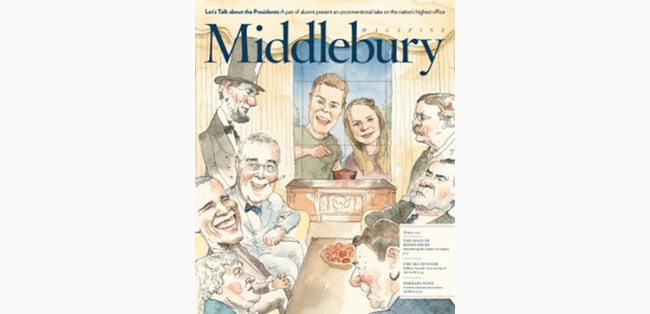You have /5 articles left.
Sign up for a free account or log in.

Winter 2020 was the last print issue before the Middlebury magazine moved online.
Courtesy of Middlebury magazine; illustration by Barry Blitt
Middlebury magazine editor Matt Jennings was working on the spring 2020 issue when the COVID-19 pandemic forced the Vermont campus to go remote in March.
“We knew immediately there would be a budget impact,” Jennings said. “We knew the financial impact of sending the students home was going to be stark.”
To avoid furloughs or layoffs, Middlebury College required all departments to cut their operating budgets by 40 percent, Jennings said. For its part, the Office of Communications and Marketing opted to suspend production of the alumni magazine.
“Paper, printing and postage are the department’s biggest budget items, so it was obvious,” Jennings said.
The decision turned out to be a blessing in disguise. Freed from the print edition’s quarterly publishing schedule, Jennings and his team could focus on developing the magazine’s digital presence. Middlebury magazine already had a website, consisting mainly of selected stories from the print edition; Jennings saw the publishing hiatus as an opportunity to ramp up the digital content.
He started posting feature stories on the website as soon as they were finished rather than timing them to coincide with the print schedule. He added videos and a podcast series called “Alone Together,” featuring various campus constituents discussing their experience of the pandemic. And he introduced “Dispatches,” a collection of colorful weekly—which dragged out to monthly—vignettes from Middlebury faculty, students and alumni around the world.
“There were things we could do online that we didn’t have in the print version,” he said. “That’s what the pandemic allowed us to experiment with.”
‘The Pandemic Budget’
Like many facets of academe, alumni magazines have been forced to retrench in the era of COVID-19. Budget cuts prompted some institutions to reduce the number of print issues they produce each year; others, like Middlebury, temporarily stopped publishing hard copies altogether.
Either way, alumni magazine staffs finally “had to deal with their websites,” said Capstone Communications founder Erin Peterson, a consultant for higher ed and independent school magazines. While she estimates that 90 to 95 percent of alumni publications already have a web presence, the sites are often rudimentary, offering little more than PDFs of the pages from the print edition, she said. With print removed as an option, colleges had no choice but to upgrade their digital offerings.
Michelle Tedford, executive editorial director of the University of Dayton alumni magazine, credits “the pandemic budget” for pushing her staff to maximize its digital storytelling skills. Instead of producing four print editions a year as usual, for fiscal years 2021 and 2022 her office was allocated only enough funds to publish two print issues and one digital-only. The most recent online-only issue, summer 2021, added extra content—including an expanded version of the magazine’s regular “Now Read, See, Hear This” feature, which showcases the accomplishments of alumni authors, filmmakers, musicians and the like—and embedded videos, animation and other multimedia effects.
“We really as a staff stretched our expertise and found different ways to make the publication visually engaging and to tell stories in different ways,” said Tedford. “And all of those skills are things that we are going to carry forward with every other digital publication we do.”
The pandemic accelerated a shift that was already underway, said Maureen Harmon, who stepped down as director of creative and editorial content at Denison University in November to devote herself full-time to Dog Ear Consultants, a communications firm she co-founded that specializes in college magazines.
“COVID really forced us to look outside the print world,” she said. “When all the budgets got slashed, it helped us to break down those silos: What’s a print magazine, what’s digital content, what’s podcast material?”
Podcasts are becoming quite popular, she said, because they’re relatively easy to produce and can cover a lot of the same ground as magazine stories—including faculty and alumni profiles—at a fraction of the cost.
A growing number of Dog Ear’s clients are interested in pursuing a “digital-first” strategy, Harmon said.
“One of the things we’re seeing schools trying to do now is get much smarter about integrating communications,” she said. “The magazine is no longer the only tool; it’s one of many storytelling mediums.”
Bastion of Print Journalism
Alumni magazines have long been a reliable bastion of print journalism—and for good reason. Funded largely by their institutions and/or alumni subscriptions, they don’t rely on advertising revenue and so didn’t feel the loss when advertisers started abandoning print media for the internet. They remain a cherished and effective way for colleges and universities to stay connected with alumni—and offer a promising return on investment in the form of donations.
“The magazine costs a buck or two to get into somebody’s hands,” said Dale Keiger, the former longtime editor of Johns Hopkins Magazine and founder of the now-archived alumni magazine blog umagazineology. “For that amount, you’re in the house for a week or two weeks or a month. You know what development people would give just to get you on the phone?”
The benefit to institutions is clear, Keiger said; surveys consistently show a strong positive correlation between alumni reading the print magazine and engaging with the institution, whether by donating money, encouraging prospective students to apply or attending events on campus.
“The more minutes [alumni] said they spent reading a magazine, the more their participation was,” Keiger said. “It’s correlation, not causation. But it wasn’t by a little; it was really striking that the more time you kept them in the pages of the magazine, the more likely they were to participate in the university.”
According to a 2020 survey by the Ivy League Magazine Network, which represents eight alumni magazines, 84 percent of readers said they’d read four of the last four issues of their alumni magazine, spending an average of 54 minutes with each one. Nearly three-fourths said they read it “as soon as it arrives in my mailbox.”
Looking at data from 192 institutions covering 100,000 alumni, the Council for Advancement and Support of Education found that after reading an issue of their alumni publication, 32 percent of respondents “recommended the institution to a family member or potential student” and 38 percent “made a donation.”
“Very few of us give money for intellectual reasons,” said Keiger. “We give money for causes that we respond to emotionally, and we give money to places we have an emotional attachment to. The university magazine, landing in your mailbox … is the university saying, ‘It may have been 40 years since you were a student here, but you’re still one of us.’”
While Keiger acknowledges it’s important for alumni magazines to have an online presence—not least because it creates a searchable archive for the institution—he believes there’s no substitution for print.
“It’s just human behavior,” he said. “The magazine lands in your mailbox. And if the editorial staff has done it right, if you’re a good magazine, people will read you because it has shown up. They are not going to seek you out [online]. They just don’t.”
Alumni Response
Early in the pandemic, alumni readers seemed enthusiastic about embracing digital.
“At the beginning, people were feeling dislocated from everything,” said Jennings, who launched an electronic newsletter to alert readers to new content on the website. “They wrote and said, ‘I’m so happy to know you’re still there.’”
But by late spring of 2021, alumni started asking when the print magazine was coming back.
Middlebury College president Laurie Patton received notes from upset alumni saying things like, “I understand you have to switch to digital for COVID, but PLEASE don’t get rid of print altogether!” she wrote in an email.
Peterson said some of her Capstone Communications clients who went digital “had this initial pop of interest. And then they did the second issue and the interest went down to nothing. People found it novel for the first issue and then were not interested in it going forward.”
As the pandemic becomes endemic and the finances of colleges and universities stabilize, they are trying to figure out how and when to restore the print issue.
“There are people who are staying digital, because there are all these paper shortages and print costs are going up like crazy,” said Peterson.
But it’s only a matter of time before most return to print, she said.
Cornellians
Even Cornell University, which was already planning to go all-digital when the pandemic struck, isn’t abandoning print entirely.
With subscriptions to the print magazine down to about 13,000—a tiny fraction of the total alumni population of roughly 280,000—the university set out to build an all-digital alumni site called Cornellians, said Jenny Barnett, who recently retired as the editor in chief.
“It was getting to the point where it was really not sustainable as a subscription-based model,” Barnett said. “The pandemic kind of put the squeeze on a little more than it would have ordinarily.”
The May/June 2021 issue was the last print edition to go out. Cornellians launched in October, taking the place of both the Cornell alumni print magazine and Ezra, a university-relations produced magazine that went to alumni, volunteers and other friends of the institution.
In addition to rolling out new stories every week, Cornellians allows alumni to submit their own updates about, say, a new job or the birth of a child—independent of the ever-popular class notes, which are collected and written monthly by a correspondent for each class. Users can tag posts in any number of ways—by major or extracurricular activity, for instance, as well as by graduating class—to notify the interested parties.
“It might be a different affinity group or it might be that they were in the marching band and they want to connect with other people in marching band,” said Barnett.
Alumni reaction so far has been overwhelmingly positive, said Michelle Vaeth, associate vice president for alumni affairs. She said in the first two months the website was live, it had about 43,000 unique visitors—significantly more than the readership of two print issues.
Nevertheless, the university plans to resume producing and sending a print edition of the alumni magazine sometime in early 2023, which will require a paid subscription, said Vaeth.
“When we set out on this path, we knew that there was a cohort of alumni who would need or want to have a print issue,” said Vaeth. “We are digital first and that is the emphasis, but we will provide a print option.”
They are still working out the details of how many print issues to produce each year, who will receive it and how much to charge.
“It’s a small group of alumni that are interested in a paid print subscription, but it’s an important group to us,” said Vaeth.
Digital Natives Still Like Print
And it’s not necessarily alumni of a certain age; younger alumni can be just as passionate about the print edition as older alums.
“While younger alumni are more likely to get much more information for their daily lives off the web than older alumni, the percentage of them who still want to receive the physical magazine remains pretty high,” said Joseph Wakelee-Lynch, editor of LMU Magazine at Loyola Marymount University in L.A. “Like higher than two-thirds.”
Tedford noted that some University of Dayton alumni don’t consider their personal news real “unless it’s in the print magazine. So they wait because they want their words in the magazine, and they want their picture in the magazine,” she said.
Jennings recalled a Middlebury alum, five or six years out, who got married during the pandemic and wanted to announce it—“but only in print,” he said.
Middlebury magazine will resume print for the spring 2022 issue—slightly later than Jennings hoped, because of paper shortages and supply-chain hiccups. But it will be a welcome return all around.
“I think higher ed will be the last place to do away with print magazines,” said Jennings. “We have an affinity group and a broad audience that other magazine publishers would kill for. Where else can you tell stories about an astrophysicist and a classical pianist in the same issue and have it make sense?”








